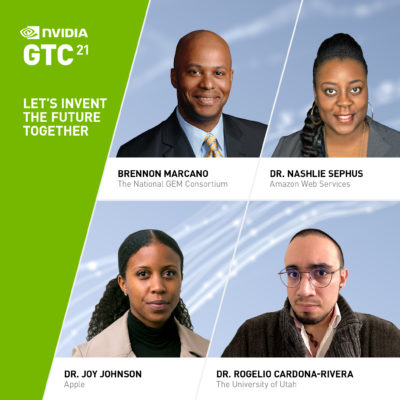NVIDIA’s GPU Technology Conference is a hotbed for sharing groundbreaking innovations — making it the perfect forum for developers, students and professionals from underrepresented communities to discuss the challenges and opportunities surrounding AI.
Last month’s GTC brought together virtually tens of thousands of attendees from around the world, with more than 20,000 developers from emerging markets, hundreds of women speakers and a variety of session topics focused on diversity and inclusion in AI.
It had 6x increase in female attendees from last fall’s event, a 6x jump in Black attendees and a 5x boost in Hispanic and Latino attendees. Dozens signed up for hands-on training from the NVIDIA Deep Learning Institute and joined networking sessions hosted by NVIDIA community resource groups in collaboration with organizations like Black in AI and LatinX in AI.
More than 1,500 sessions from GTC 2021 are now available for free replay on NVIDIA On-Demand — including panel discussions on AI literacy and efforts to grow the participation of underrepresented groups in science and engineering.
Advocating for AI Literacy Among Youth
In a session called “Are You Smarter Than a Fifth Grader Who Knows AI?,” STEM advocates Justin Shaifer and Maynard Okereke (known as Mr. Fascinate and the Hip Hop M.D., respectively) led a conversation about initiatives to help young people understand AI.
Given the ubiquity of AI technologies, being surrounded by it “is essentially just how they live,” said Jim Gibbs, CEO of the Pittsburgh-based startup Meter Feeder. “They just don’t know any different.”
But school curriculums often don’t teach young people how AI technologies work, how they’re developed or about AI ethics. So it’s important to help the next generation of developers prepare “to take advantage of all the new opportunities that there are going to be for people who are familiar with machine learning and artificial intelligence,” he said.
Panelist Lisa Abel-Palmieri, CEO of the Boys & Girls Clubs of Western Pennsylvania, described how her organization’s STEM instructors audited graduate-level AI classes at Carnegie Mellon University to inform a K-12 curriculum for children from historically marginalized communities. NVIDIA recently announced a three-year AI education partnership with the organization to create an AI Pathways Toolkit that Boys & Girls Clubs nationwide can deliver to students, particularly those from underserved and underrepresented communities.
And Babak Mostaghimi, assistant superintendent of Georgia’s Gwinnett County Public Schools shared how his team helps students realize how AI is relevant to their daily experiences.
“We started really getting kids to understand that AI is already part of your everyday life,” he said. “And when kids realize that, it’s like, wait a minute, let me start asking questions like: Why does the algorithm behind something cause a certain video to pop up and not others?”
Watch the full session replay on NVIDIA On-Demand.
Diverse Participation Brings Unique Perspectives
Another panel, “Diversity Driving AI Innovation,” was led by Brennon Marcano, CEO of the National GEM Consortium, a nonprofit focused on diversifying representation in science and engineering.
 Researchers and scientists from Apple, Amazon Web Services and the University of Utah shared their experiences working in AI, and the value that the perspectives of underrepresented groups can provide in the field.
Researchers and scientists from Apple, Amazon Web Services and the University of Utah shared their experiences working in AI, and the value that the perspectives of underrepresented groups can provide in the field.
“Your system on the outside is only as good as the data going in on the side,” said Marcano. “So if the data is homogeneous and not diverse, then the output suffers from that.”
But diversity of datasets isn’t the only problem, said Nashlie Sephus, a tech evangelist at Amazon Web Services AI who focuses on fairness and identifying biases. Another essential consideration is making sure developer teams are diverse.
“Just by having someone on the team with a diverse experience, a diverse perspective and background — it goes a long way. Teams and companies are now starting to realize that,” she said.
The panel described how developers can mitigate algorithmic bias, improve diversity on their teams and find strategies to fairly compensate focus groups who provide feedback on products.
“Whenever you are trying to create something in software that will face the world, the only way you can be precisely coupled to that world is to invite the world into that process,” said Rogelio Cardona-Rivera, assistant professor at the University of Utah. “There’s no way you will be able to be as precise if you leave diversity off the table.”
Watch the discussion here.
Learn more about diversity and inclusion at GTC, and watch additional session replays on NVIDIA On-Demand. Find the GTC keynote address by NVIDIA CEO Jensen Huang here.
